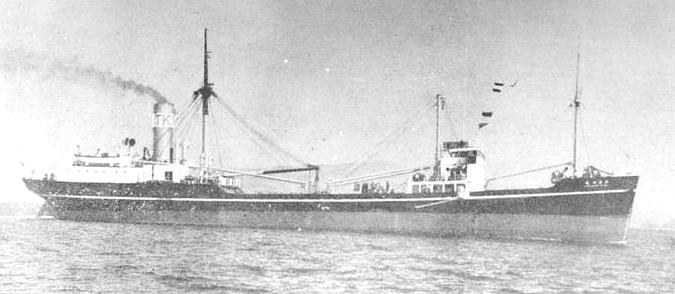
Prior to and during the Pacific War, the Imperial Japanese Navy enlisted some of Japan's merchant fleet's cargo, passenger-cargo ships and liners. They were converted to military use and became Tokusetsu Unsosen Kyusuisen , (Converted Water Tankers), used to supply fresh water to other ships. Between 1937 and 1945, nine Kyusuisen were employed by the IJN. One ship was later rerated an auxiliary transport during the war. Other ships were also requisitioned by the IJN but not enlisted. They were called Ippan Choyosen (General Requisitioned Ships) and manned by civilian crews. IJA and the civilian shipping administration requisitioned many other ships. To summarize, during the war employment of ex-merchant ships was divided into three main administrative categories:A = requisitioned and operated by the Japanese Army and named Rikugun Yusosen (IJA Transports). They include Cargos, Passenger-Cargos, Liners and Tankers. B = requisitioned and operated by the Japanese Navy with civilian crew (captain often being Navy Reserve).These are named Ippan Choyosen. C = controlled and operated by the Senpaku UnŽeikai (Civilian Shipping Administration). X = requisitioned by the IJN and converted into armed Naval Auxiliaries with IJN crews (gunboats, minesweepers, etc.) and named Tokusetsu Kansen followed by another suffix for the ships use. Beside the above categories, there were many shared employments Army/Civilian (A/C) and Navy/Civilian (B/C). These ships were respectively called Rikugun Haitosen and Kaigun Haitosen. Normally, this meant that the vessel on its outbound journey was under Army or Navy control carrying troops, military supplies, etc. and on its return voyage was carrying cargo for the benefit of the civilian owner of ship. While used by the Army, the Haitosen also received Army transport numbers like Army requisitioned vessels (A). Employments by Army or Navy could also be expanded, meaning that the ship was used by Army/Navy for one full turn (outward and homeward voyage) or even a series of voyages. This page will cover the activities of the nine IJN Converted Auxiliary water tankers. Water tankers were used to supply remote outposts with fresh drinking water, particularly in the SW Pacific and to supply warships and transports with water. Fresh water was produced by distillation plants (condensers) on board or sometimes drawn from natural water sources. Tanks were fitted in the holds to hold the water.

Mr. Berend van der Wal got interested in the Japanese Navy through hobby ship modelling. He's been researching the Japanese Navy since 1978. He is an IT support engineer and resides in the Netherlands.
Mr. Gilbert Casse is a maritime historian and researcher. Retired from the aerospace industry, and later from managing Le Mans racing cars and drivers, his advocation is ship modelling, maritime photos and paintings. He resides on the SW coast of France.
Mr. Peter Cundall is a maritime historian and researcher who specializes in merchant ships and convoys. He resides in Australia and works in the maritime industry.
Questions to the authors concerning these TROMs should be posted on the Discussion and Questions board. 
 |